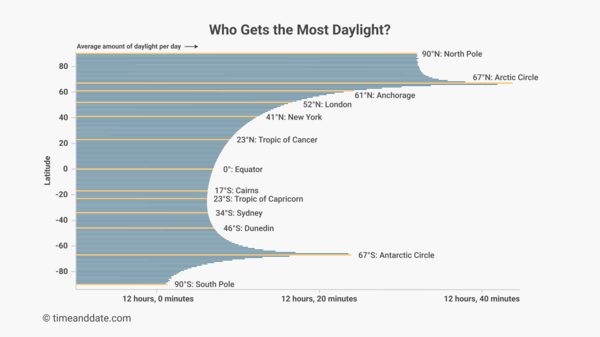Next Year’s Summer Will Be 15 Minutes Shorter
Earth reaches aphelion—its farthest point from the Sun—on July 5, 2024. The Earth-Sun distance is not what causes the seasons, but it does affect their length, along with other complex factors.

Hold the ice cream: the length of summer varies slightly from year to year.
©iStockphoto.com/Pollyana Ventura
Aphelion, and Other Complexities
This year’s aphelion—the point on Earth’s orbit where it is at its farthest distance from the Sun—happens at 05:06 UTC on July 5.
One of the consequences of aphelion is that summer lasts longer in the Northern Hemisphere, and will get longer still over the coming centuries.
But, for a variety of complex reasons, the Northern Hemisphere summer in 2025 will be about 15 minutes shorter than in 2024.
What Has the Earth-Sun Distance Got to Do with the Seasons?
Astronomers define the Northern Hemisphere summer as the period between the June solstice and September equinox. For the Southern Hemisphere, summer is the period between the December solstice and March equinox.
Solstices and equinoxes are caused by Earth’s tilt: they are not connected to Earth’s distance from the Sun.
However, the Northern Hemisphere summer coincides with the date of aphelion. When Earth is farther from the Sun, it moves more slowly along its orbit, and it takes more time to go from a solstice to an equinox.
On the other hand, the Southern Hemisphere summer coincides with the date of perihelion, the Earth’s closest point to the Sun, which happens around the beginning of January. Here, Earth moves more quickly, and it takes less time to go from a solstice to an equinox.
The result? The Northern Hemisphere has a longer summer—and a shorter winter—than the Southern Hemisphere. The difference in length is around 4 days.
A Tale of Two Hemispheres
Lengths of the Seasons, 2024–2025
| Northern Hemisphere | Southern Hemisphere | Duration |
|---|---|---|
| Spring | Autumn/Fall | 92 days, 17 hrs, 44 mins |
| Summer | Winter | 93 days, 15 hrs, 52 mins |
| Autumn/Fall | Spring | 89 days, 20 hrs, 37 mins |
| Winter | Summer | 88 days, 23 hrs, 40 mins |
Sources: timeanddate.com; JPL DE430
Longer Summer = More Daylight Overall
There are further consequences to the date of aphelion. A higher number of long summer days for locations north of the equator means that cities like New York, London, and Tokyo get more daylight overall than Buenos Aires, Cape Town, and Sydney.
Hours of daylight for your city
The following bar chart shows the average amount of daylight per day, over the course of one year, for every line of latitude from the North Pole at 90° north, to the South Pole at 90° south.


Consequences of aphelion: generally speaking, cities in the Northern Hemisphere get more daylight over the course of the year than cities in the Southern Hemisphere.
©timeanddate
The reason for the spikes around the Arctic and Antarctic Circles in the above chart is the way the Sun skims along the horizon in the polar regions.
Read more about who gets the most daylight
Long-Term Variations
The calendar we use today—the Gregorian calendar—was carefully designed so that the equinoxes and solstices always happen around the same dates.
Not so the dates of aphelion and perihelion: over the course of many centuries, these dates shift through the calendar.
A thousand years from now, aphelion will happen toward the end of July, not the beginning. This is closer to the mid-point of summer, which means Earth’s average speed over the summer period will be even slower.
Accordingly, a thousand years from now, the Northern Hemisphere summer/Southern Hemipshere winter will be about six hours longer than it is today.
Short-Term Fluctuations
So, over thousands of years, the lengths of the seasons gradually rise and fall by a few days. But within this general trend, there are much smaller fluctuations from one year to the next.
These small fluctuations in the lengths of seasons—a few minutes here, a few minutes there—are caused by the complexity of Earth’s motion through space.
This complexity includes subtle changes in the direction of Earth’s spin axis, and the shape and smoothness of Earth’s orbit around the Sun. It is all caused by the gravitational pull of the Moon, as well as Jupiter and other solar system bodies.
Next year will see a particularly sharp drop in the length of the Northern Hemisphere summer/Southern Hemisphere winter: it will fall from 93 days, 15 hrs, 52 mins in 2024, to 93 days, 15 hrs, 37 mins in 2025—making next year’s northern summer around 15 minutes shorter.
Year-to-Year Ups and Downs
Lengths of Northern Hemisphere Summer/Southern Hemisphere Winter
| Year | Duration |
|---|---|
| 2022 | 93 days, 15 hrs, 49 mins |
| 2023 | 93 days, 15 hrs, 52 mins |
| 2024 | 93 days, 15 hrs, 52 mins |
| 2025 | 93 days, 15 hrs, 37 mins |
| 2026 | 93 days, 15 hrs, 40 mins |
Sources: timeanddate.com; JPL DE430